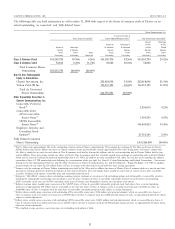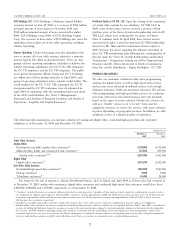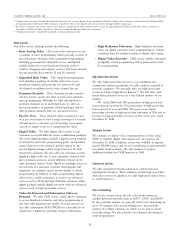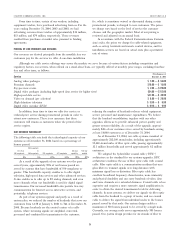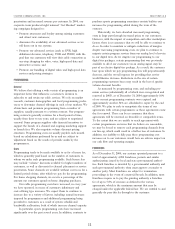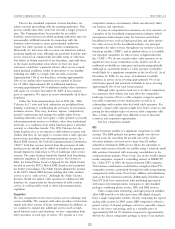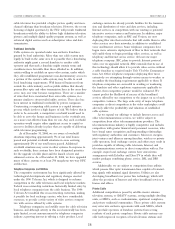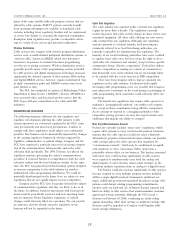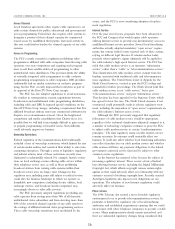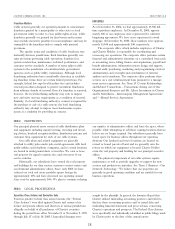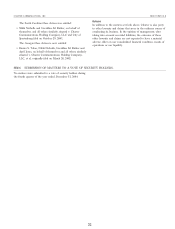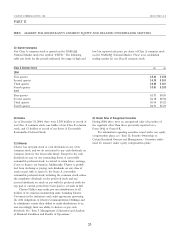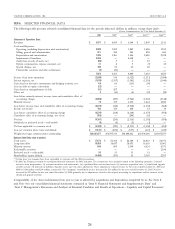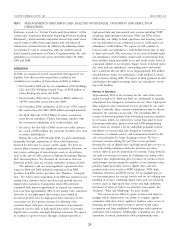Charter 2004 Annual Report Download - page 25
Download and view the complete annual report
Please find page 25 of the 2004 Charter annual report below. You can navigate through the pages in the report by either clicking on the pages listed below, or by using the keyword search tool below to find specific information within the annual report.
CHARTER COMMUNICATIONS, INC. 2004 FORM 10-K
many of the same satellite-delivered program services that are Cable Rate Regulation
offered by cable systems. SMATV systems currently benefit The cable industry has operated under a federal rate regulation
from operating advantages not available to franchised cable regime for more than a decade. The regulations currently
systems, including fewer regulatory burdens and no requirement restrict the prices that cable systems charge for basic service and
to service low density or economically depressed communities. associated equipment. All other cable offerings are now univer-
Exemption from regulation may provide a competitive advan- sally exempt from rate regulation. Although rate regulation
tage to certain of our current and potential competitors. operates pursuant to a federal formula, local governments,
Wireless Distribution commonly referred to as local franchising authorities, are
Cable systems also compete with wireless program distribution primarily responsible for administering this regulation. The
services such as multi-channel multipoint distribution systems or majority of our local franchising authorities have never certified
‘‘wireless cable,’’ known as MMDS, which uses low-power to regulate basic cable rates, but they retain the right to do so
microwave frequencies to transmit television programming (and order rate reductions and refunds), except in those specific
over-the-air to paying customers. Wireless distribution services communities facing ‘‘effective competition.’’ Federal law defines
generally provide many of the programming services provided effective competition as existing in a variety of circumstances
by cable systems, and digital compression technology increases that historically were rarely satisfied, but are increasingly likely
significantly the channel capacity of their systems. Both analog to be satisfied with the recent increase in DBS competition.
and digital MMDS services, however, require unobstructed ‘‘line There have been frequent calls to impose expanded rate
of sight’’ transmission paths and MMDS ventures have been regulation on the cable industry. Confronted with rapidly
quite limited to date. increasing cable programming costs, it is possible that Congress
The FCC has completed its auction of Multichannel Video may adopt new constraints on the retail pricing or packaging of
Distribution & Data Service (‘‘MVDDS’’) licenses. MVDDS is a cable programming. Such constraints could adversely affect our
new terrestrial video and data fixed wireless service that the operations.
FCC hopes will spur competition in the cable and DBS The federal rate regulations also require cable operators to
industries. maintain a ‘‘geographically uniform’’ rate within each commu-
nity, except in those communities facing effective competition.
REGULATION AND LEGISLATION As we attempt to respond to a changing marketplace with
competitive pricing practices, we may face legal restraints and
The following summary addresses the key regulatory and challenges that impede our ability to compete.
legislative developments affecting the cable industry. Cable
system operations are extensively regulated by the FCC, some Must Carry/Retransmission Consent
state governments and most local governments. A failure to Federal law currently includes ‘‘must carry’’ regulations, which
comply with these regulations could subject us to substantial require cable systems to carry certain local broadcast television
penalties. Our business can be dramatically impacted by changes stations that the cable operator would not select voluntarily.
to the existing regulatory framework, whether triggered by Alternatively, popular commercial television stations can prohibit
legislative, administrative, or judicial rulings. Congress and the cable carriage unless the cable operator first negotiates for
FCC have expressed a particular interest in increasing competi- ‘‘retransmission consent,’’ which may be conditioned on signifi-
tion in the communications field generally and in the cable cant payments or other concessions. Either option has a
television field specifically. The 1996 Telecom Act altered the potentially adverse effect on our business. The burden associated
regulatory structure governing the nation’s communications with must carry could increase significantly if cable systems
providers. It removed barriers to competition in both the cable were required to simultaneously carry both the analog and
television market and the local telephone market. At the same digital signals of each television station (dual carriage), as the
time, the FCC has pursued spectrum licensing options designed broadcast industry transitions from an analog to a digital format.
to increase competition to the cable industry by wireless The burden could also increase significantly if cable systems
multichannel video programming distributors. We could be become required to carry multiple program streams included
materially disadvantaged in the future if we are subject to new within a single digital broadcast transmission (multicast car-
regulations that do not equally impact our key competitors. riage). Additional government-mandated broadcast carriage obli-
Congress and the FCC have frequently revisited the subject gations could disrupt existing programming commitments,
of communications regulation, and they are likely to do so in interfere with our preferred use of limited channel capacity and
the future. In addition, franchise agreements with local govern- limit our ability to offer services that would maximize customer
ments must be periodically renewed, and new operating terms appeal and revenue potential. Although the FCC issued a
may be imposed. Future legislative, regulatory, or judicial decision on February 10, 2005, confirming an earlier ruling
changes could adversely affect our operations. We can provide against mandating either dual carriage or multicast carriage, that
no assurance that the already extensive regulation of our decision could be appealed or Congress could legislate addi-
business will not be expanded in the future. tional carriage obligations.
15


